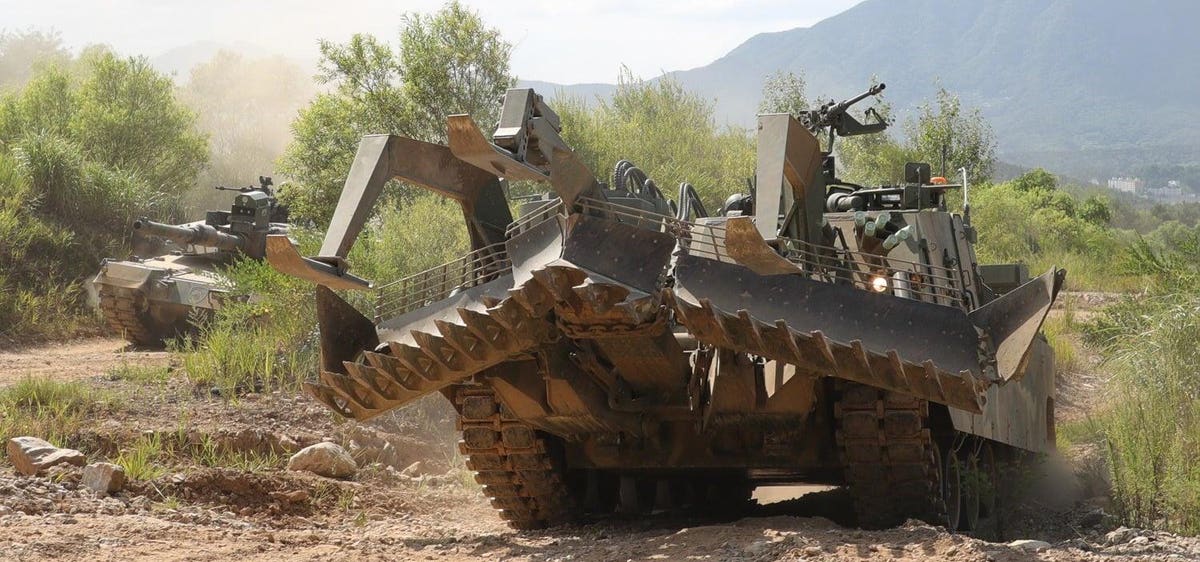In a single cataclysmic assault across an impossibly dense Russian minefield in southern Ukraine’s Zaporizhzhia Oblast in early June, the Ukrainian army’s 47th Mechanized Brigade abandoned three of its rare, ex-Finnish Leopard 2R breaching vehicles alongside a couple of dozen other armored vehicles.
Finnish firm Patria manufactured just six of the two-person Leopard 2Rs by popping the turrets off of 69-ton Leopard 2 tanks and adding a full-width mineplow from British firm Pearson Engineering.
Finland donated all of the Leopard 2Rs to Ukraine, meaning every one of the mineclearing vehicles the Ukrainians lost was a vehicle it couldn’t replace. At least not with an identical piece of equipment.
Fortunately for Ukraine, South Korean firm Hyundai produces a similar breaching vehicle: the K600. And Seoul just pledged two of the 62-ton vehicles to Kyiv. South Korea will deliver the K600s “as soon as possible,” a government source told Chosun.
Hyundai makes a two-person K600 by removing the turret from a K1 tank—a South Korean variant of the American M-1—and adding a plow, an articulated excavator arm and a device for safely triggering magnetic mines.
The K600 is compatible with two dozer blades, both made by Pearson. A wedge-shape blade works best for digging up and shoving aside buried mines. A straight blade works better for generic engineering tasks: filling in trenches, digging revetments, et cetera.
Hyundai delivered the first K600s to the South Korean army in 2020. The South Korean and Ukrainian governments began discussing a K600 transfer back in May; the South Koreans finally approved the deal this month. There’s one caveat. The Ukrainians must deploy the vehicles only in “humanitarian” roles.
The caveat is meaningless. Arguably any mineclearing operation—even one that occurs while the engineers are under enemy fire—is humanitarian.
It remains to be seen which Ukrainian unit will operate the K600s: it might not be the 47th Mechanized Brigade, which is down at least Leopard 2R after recovering the three immobilized mineclearers from that Zaporizhzhia minefield and possibly repairing the least damaged pair.
In 14 weeks of hard fighting since launching its long-anticipated southern counteroffensive, Ukrainian brigades have gotten through or around the densest minefields buffering the first line of trenches, of three, forming Russia’s so-called Surovikin Line in Zaporizhzhia and Donetsk Oblasts.
But that doesn’t mean mines no longer are a problem for the Ukrainians. There still are potentially hundreds of thousands of mines between the current line of contact and the Ukrainians’ main objectives: the Russian-held cities of Melitopol and Mariupol, both 50 miles to the south.
As a bonus, the K600—in contrast to the Leopard 2R—can do a lot more than just clear mines. Unlike the Leopard 2R, the K600 has an excavator arm for digging trenches and reducing berms. And by swapping dozer blades, a K600 crew can pivot between mineclearing and construction roles.
“The same vehicle, or set of vehicles, can therefore easily perform minefield breaching, earth and obstacle movement, vehicle recovery and assault gap-crossing according to mission requirements,” Pearson noted.
All that is to say, Ukraine’s K600s will be useful even after all the mines have been cleared. Not that that’s going to happen anytime soon in a country whose soil is among the explosive on Earth.
Read the full article here





